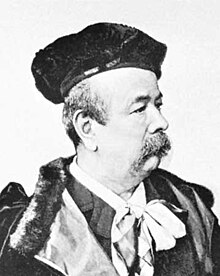Charles Frederick Worth
Charles Frederick Worth (born November 13, 1825 in Bourne , Lincolnshire , † March 10, 1895 in Paris ) was an English fashion designer who is considered the founder of haute couture .
Life
At the age of 13, Worth began an apprenticeship as a textile salesman with the London cloth trading company Swan & Edgar in London and then with Lewis & Allenby , then silk supplier to Queen Victoria . During this time he also visited the National Gallery , where he was fascinated by the historical robes depicted on portraits. In 1845 he went to Paris to Gagelin & Opigez , a trading house for high-quality silk fabrics. There he met his future wife Marie Augustine Vernet . She worked as a mannequin who demonstrated scarves and hats. Worth designed some simple dresses for her that showed off the house's silks particularly well, and customers began to ask for copies of these models. At the first World's Fair in 1851, the Great Exhibition in London, Worth received a gold medal for his creations. Four years later at the Paris World's Fair in 1855 he showed a coat hanging freely from the shoulders ( Manteau de cour ), with which he won 1st prize.
Worth, who had risen to junior partner in the company in 1856, tried to persuade the co-owners to expand the business scope to the production of clothes. However, they were reluctant to enter a business area that had such a poor reputation (compared to the fabric trade). However, Worth found a wealthy Swede, Otto Bobergh , who was willing to take on the financing of a fashion house. In 1858 they opened the company under the name Worth et Bobergh on Rue de la Paix in Paris. The company achieved success very quickly. The Empress Eugénie noticed an evening wear made of silver tulle, daisies, pink hearts and silver sequins , which the wife of the Austrian ambassador wore at a state ball, and Worth became purveyor to the court. Other famous names followed, for example Queen Victoria, Elisabeth "Sissi" of Austria , Princess Pauline von Metternich , Lillie Langtry , who was celebrated for her beauty , the actress Sarah Bernhardt , the soprano Nellie Melba and the demi-world lady Cora Pearl . Many of his customers accepted the long journey to Paris to be dressed by Worth.
Worth flattered his customers with luxurious materials and careful cut. While the customers previously specified the design of their clothes, he presented model creations in fashion shows four times a year. The customer selected a model, which was then made to measure using a fabric of her choice. In 1870 the company employed over 1200 seamstresses who made several hundred dresses every week. His models were so expensive that even wealthy customers had them changed according to the latest fashion.
During the Franco-Prussian War of 1870/71 the fashion house closed temporarily and the rooms were used as a hospital. When it reopened in 1871, the financier Bobergh left the company and Worth took his two sons, Gaston and Jean-Philippe, into the business. These continued to run the company even after his death. In 1956, the haute couture atelier in Paris was closed, and the London branch followed in the early 1970s.
Worth revolutionized the fashion industry with his way of producing clothes. He was the first fashion designer to be understood more as an artist than a craftsman. In addition, his influence on fashion as a whole was very great. As early as 1867 he created a sales program that enabled foreign buyers to acquire patterns. In line with his self-image as an artist, a sticker with his name was sewn into his models. His clothes were "complete" when they left his studio; unlike other tailors, it was not intended that a milliner would dress it up with accessories. Worth changed the female silhouette, among other things, by relocating the waist and the hem of the skirt and introducing the skirt, which is bulging at the back, and the turn around . He also caused a stir when he shortened the length of the empress's skirt by 25 centimeters.
In 1962, the Brooklyn Museum in New York dedicated an exhibition to the fashion revolutionary Worth.
- Charles Frederick Worth creations
Robe in the museum at Bury St Edmunds
Elisabeth "Sissi" from Austria with a dress from Worth. Portrait of Franz Xaver Winterhalter , 1865
literature
- Gertrud Lehnert: Women make fashion - famous fashion designers from Coco Chanel to Vivienne Westwood , Dortmund 1998, ISBN 3-492-23024-5
- Ingrid Loschek : Reclam's fashion and costume lexicon. 5th edition. Reclam, Stuttgart 2005, ISBN 3-15-010577-3 , p. 581
- Andrew Tucker, Tamsin Kingswell: Mode , Munich 2000. ISBN 3-7913-2428-4
- La Mode: Paris and the Development of French Fashion Industrie . In: Pamela A. Parmal, Didier Grumbach (Ed.): Fashion Show . Boston 2006, pp. 62-102
- NJ Stevenson: The History of Fashion. Styles, trends and stars. Haupt, Bern u. a. 2011, ISBN 978-3-258-60032-1 , pp. 50-53
- Edith Saunders: King of the Elegant World. Worth, the fashion designer from Paris. Walter, Olten and Freiburg Brsg. 1957
Web links
- Biography and pictures in the Metropolitan Museum (English)
Individual evidence
- ↑ Philip Fitzgerald: Mode - 3000 years of costumes, trends, styles, designers . Dorling Kindersley, Munich 2013, ISBN 978-3-8310-2389-9 , p. 199
| personal data | |
|---|---|
| SURNAME | Worth, Charles Frederick |
| BRIEF DESCRIPTION | English fashion designer, founder of haute couture |
| DATE OF BIRTH | November 13, 1825 |
| PLACE OF BIRTH | Bourne , Lincolnshire |
| DATE OF DEATH | March 10, 1895 |
| Place of death | Paris |





